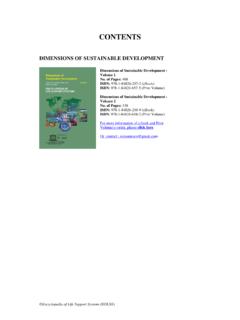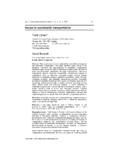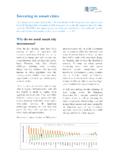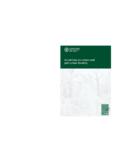Transcription of 2017 Global Food Policy Report - Food and Agriculture ...
1 2017 Global food Policy REPORTIFPRIA bout IFPRIThe International food Policy Research Institute (IFPRI), established in 1975, provides research-based Policy solutions to sustainably reduce poverty and end hunger and malnutrition. The Institute conducts research, communicates results, optimizes partnerships, and builds capacity to ensure sustainable food production, promote healthy food systems, improve markets and trade, transform Agriculture , build resilience, and strengthen institutions and governance. Gender is considered in all of the Institute s work. IFPRI collaborates with partners around the world, including development implementers, public institutions, the private sector, and farmers Peer-Reviewed PublicationCopyright 2017 International food Policy Research Institute (IFPRI).This publication is licensed for use under a Creative Commons Attribution International License (CC BY ). Subject to attribution, you are free to share (copy and redistribute the material in any medium or format), adapt (remix, transform, and build upon the material) for any purpose, even conTenT: The International food Policy Research Institute does not necessarily own each compo-nent of the content contained within the work.
2 The International food Policy Research Institute therefore does not warrant that the use of any third-party-owned individual component or part contained in the work will not infringe on the rights of those third parties. The risk of claims resulting from such infringement rests solely with you. If you wish to re-use a component of the work, it is your responsibility to determine whether permis-sion is needed for that re-use and to obtain permission from the copyright owner. Examples of components can include, but are not limited to, tables, figures, or ciTaTion: International food Policy Research Institute. 2017 . 2017 Global food Policy Report . Washington, DC: International food Policy Research Institute. boundaries and names shown and the designations used on the maps do not imply official endorsement or acceptance by the International food Policy Research Institute (IFPRI).International food Policy Research Institute1201 Eye Street NW, 12th floorWashington, DC 20005 Telephone: + : 978-0-89629-252-9 DOI: Data is available from the Library of creditsCover: (l-r) Ed Kashi/National Geographic Creative; Akash/Panos; Eric Miller/Panos; Getty Images; XPACIFICA/National Geographic images: p.
3 7 Sven Torfinn/Panos; p. 15 Akash/Panos; p. 25 Brian Sokol/Panos; p. 35 Sven Torfinn/Panos; p. 43 Steve Raymer/National Geographic Creative; p. 51 Bobby Haas/ National Geographic Creative; p. 58 Ian Teh/Panos; p. 84 Adam design: James SampleBook design and layout: James Sample and David PophamEditorial manager: Pamela Stedman-EdwardsivContentsPREFACE 3 ACKNOWLEDGMENTS 5 Chapter 1 food Policy IN 2016 2017 : food SECURITY AND NUTRITION IN AN URBANIZING WORLD 6 Shenggen FanChapter 2 SMALLHOLDERS AND URBANIZATION: STRENGTHENING RURAL-URBAN LINKAGES TO END HUNGER AND MALNUTRITION 14 Jos Graziano da Silva and Shenggen FanChapter 3 food SECURITY AND NUTRITION: GROWING CITIES, NEW CHALLENGES 24 Marie Ruel, James Garrett, and Sivan YosefChapter 4 CHANGING DIETS: URBANIZATION AND THE NUTRITION TRANSITION 34 Corinna Hawkes, Jody Harris, and Stuart GillespieChapter 5 AGRICULTURAL VALUE CHAINS.
4 HOW CITIES RESHAPE food SYSTEMS 42 Bart Minten, Thomas Reardon, and Kevin ChenChapter 6 GOVERNANCE: INFORMAL food MARKETS IN AFRICA S CITIES 50 Danielle ResnickREGIONAL DEVELOPMENTS 58 Africa 60 Tsitsi Makombe, Julia Collins, and Ousmane BadianeMiddle East and North Africa 64 Clemens Breisinger, Fatma Abdelaziz, and Nadim KhouriCentral Asia 67 Kamiljon Akramov, Allen Park, and Jarilkasin IlyasovSouth Asia 71 Anjani Kumar, Akhter Ahmed, Stephen Davies, and P. K. JoshiEast Asia 75 Kevin Chen, Peter Timmer, and David DaweLatin America and the Caribbean 79 Eugenio D az-Bonilla and M ximo ToreroFOOD Policy INDICATORS.
5 TRACKING CHANGE 84 Agricultural Science and Technology Indicators (ASTI) 86 Statistics of Public Expenditure for Economic Development (SPEED) 92 Global Hunger Index (GHI) 98 food Policy Research Capacity Indicators (FPRCI) 102 Agricultural Total Factor Productivity (TFP) 105 International Model for Policy Analysis of Agricultural Commodities and Trade (IMPACT) 110 NOTES 119 PrefaceThe 2017 Global food Policy Report provides a comprehensive overview of major food Policy developments and events. In this sixth annual Report , leading researchers, Policy makers, and practitioners review what hap-pened in food Policy , and why, in 2016 and look forward to 2017 .
6 This year s Report has a special focus on the challenges and opportunities created by rapid urbanization, especially in low- and middle-income countries, for food security and 2016, the world embarked on implementing the 2030 Agenda for Sustainable Development, with the goal of eliminating extreme poverty and hunger. The Paris Agreement on Climate Change also entered into force. Other major international developments included UN endorsement of the Framework for Action that emerged from the Second International Conference on Nutrition, the launch of the UN Decade of Action on Nutrition (2016 2025), and the New Urban Agenda adopted at the Habitat III summit in Quito, Ecuador. Also of note were the G7 s commitment to prioritizing nutrition, the G20 s emphasis on agricultural innovation for sustainable development, and the record replenishment for the International Development Association (IDA).Progress in many places on reducing poverty and malnutrition has been notable, with extreme poverty at the lowest level ever.
7 Hunger rates have fallen substantially in recent years, even dramatically in some coun-tries, accompanied by falling levels of child stunting and other indicators of malnutrition. Agricultural produc-tion was up in 2016, and as a result, food prices were down, with benefits for and economic uncertainties also marked the year. Continuing conflicts and record numbers of refugees in the Middle East increased the need for humanitarian aid. El Ni o and other environmental shocks reduced harvests in Latin America, parts of Asia, and eastern and southern Africa, increasing food insecurity. Political events in 2016, including the British vote to leave the European Union and the US elections, along with continuing economic stagnation and recession in major economies leave the prospects for 2017 more uncertain than in previous 2017 , the world must move forward with its commitments on the Sustainable Development Goals. Working to improve food systems and strengthening the ties between rural and urban areas offer great prom-ise for meeting those goals and ending hunger and covered in the 2017 Global food Policy Report were the result of consultations with experts in the field.
8 For inclusion in this Report , a topic must represent a new development in food Policy or a new way of looking at an important food issue; the topic has to be international in scope; and assessments and rec-ommendations must be backed by evidence based on high-quality research results or expert judgment. Supplemented by data tables and visualizations illustrating trends in key food Policy indicators at the country level, the Report paints a full picture of food hope this Report is met with interest not only by Policy makers who shape the food Policy agenda, but also by business, civil society, and media, who all have a stake in food policies that benefit the world s poorest and most vulnerable FanDirector General3 AcknowledgmentsThe 2017 Global food Policy Report was prepared under the overall leadership of Shenggen Fan and a core team comprising Jamed Falik, Rajul Pandya-Lorch, Katrin Park, Pamela Stedman-Edwards, Klaus von Grebmer, Sivan Yosef, and Laura and data contributions were made by Fatma Abdelaziz, Akhter Ahmed, Kamiljon Akramov, Luz Marina Alvare, Suresh Babu, Ousmane Badiane, Nienke Beintema, Jill Bernstein, Clemens Breisinger, Kevin Chen, Julia Collins, Stephen Davies, David Dawe, Eugenio D az-Bonilla, Paul Dorosh, James Garrett, Stuart Gillespie.
9 Jos Graziano da Silva, Jody Harris, Corinna Hawkes, Jarilkasin Ilyasov, Michael Johnson, P. K. Joshi, Nadim Khouri, Anjani Kumar, Tsitsi Makombe, Bart Minten, Alejandro Nin-Pratt, Allen Park, Nilam Prasai, Thomas Reardon, Danielle Resnick, Mark Rosegrant, Christopher Rue, Marie Ruel, Timothy Sulser, Timothy Thomas, Peter Timmer, M ximo Torero, Keith Wiebe, Indira Yerramareddy, and Sivan of the Report was led by Jamed Falik, David Popham, and Pamela Stedman-Edwards. Team members include Aliana Bailey, Melissa Cooperman, Michael Go, James Sample, and Caroline Smith. Editorial assistance was provided by Amy Gautam and Tracy Report underwent a peer review by IFPRI s Publications Review Committee, chaired by Gershon year 2016 saw important signs of resolve and com-mitments to sustainable development and food secu-rity. Yet the year also witnessed growing uncertainties linked to stagnant growth in the Global economy, growing income inequalities everywhere, worsening refugee crises, increased polarization and populism among major donor countries, and rapid changes in the political landscape.
10 These uncertainties and persistent challenges will prove to be a major test of whether the momentum created will pro-pel the new sustainable development agenda forward and whether action will be taken to improve the lives of millions of people who continue to lack the most basic necessities namely, food , shelter, and BACK AT 2016: A GLIMMER OF HOPED espite experiencing a sixth year of Global economic stagnation in 2016, some positive signs emerged of bet-ter things to come. Take poverty, for example. World Bank projections suggest that for the first time in history, the number of people living in extreme poverty fell below 10 percent of the Global While the rates may have fallen, the numbers of extremely poor people in the world remain too high hundreds of millions of people still live on less than US$ a day (the current benchmark for extreme poverty). Global hunger rates are also expected to have fallen in 2016, with less than 11 percent of the world suffering from undernourishment a drop from 19 percent in Advancements were made in countries such as Bangladesh, which cut hunger from 33 percent to 16 percent between the periods 1990 1992 and 2014 2016.


















